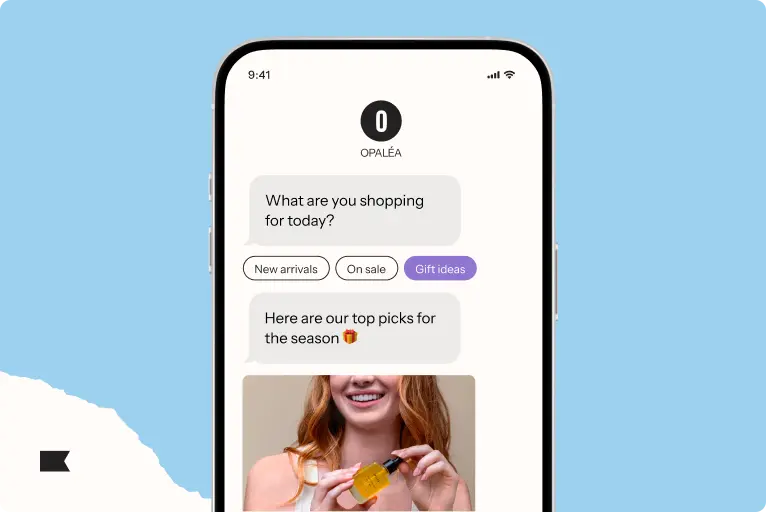The 2025 guide to conversational SMS marketing

If you take away one thing from this guide, let it be this: the biggest mistake businesses make with SMS marketing is treating it like email.
Email marketing is largely one-way—great for brand building, nurturing, and conversion over time. But SMS is different. It’s personal. It’s where people chat with friends, plan their day, and engage in quick, meaningful interactions.
“Conversational SMS is where engagement really compounds,” says Jacob Paduch, founding partner at Aplo Group and Allan. “Particularly for brands with higher price points, longer consideration periods, or more education required, conversational strategies can really shift SMS from a broadcast channel to a relationship channel for the customer.”
��“The engagement earned from two-way messaging can be the difference maker given the changes coming with iOS 26,” he adds.
A recent Klaviyo survey of more than 8,500 consumers confirmed that SMS speeds time to purchase and that people who buy from SMS are buying more often.
All of this is why conversational SMS is a large part of growing SMS strategies. Instead of sending one-way promotional messages, brands can now create two-way interactions that provide personalized recommendations, gather customer insights, and drive higher engagement.
What is conversational SMS?
Conversational SMS is more than just two-way messaging. While two-way SMS allows a customer to reply to a brand, conversational SMS goes further by responding intelligently to customer inputs, collecting preferences, and tailoring recommendations in real time.
This is not traditional chatbot AI or human agent messaging. Instead, it’s a powerful way to make SMS interactive and dynamic—turning simple text messages into meaningful customer experiences.
Conversational SMS benefits and blockers
Today’s customers expect more than one-size-fits-all marketing. They want experiences tailored to their preferences, behaviors, and needs. Conversational SMS delivers on this expectation by:
- Driving more conversions: Guiding customers toward the right products through interactive product quizzes and personalized recommendations.
- Building loyalty through relevance: Learning from customer responses and using that data to shape future interactions.
- Creating an owned marketing channel: Unlike third-party platforms, SMS lets you engage customers directly, without relying on algorithms.
So, with so many benefits, what is stopping so many brands from using conversational SMS more regularly? Well, there are several blockers, most of them unfounded beliefs:
- Lack of internal resources: Some businesses worry that managing two-way SMS interactions requires a dedicated team. However, with automated workflows and smart segmentation, brands can engage customers without significant manual effort.
- Concerns about compliance: Navigating SMS regulations can feel daunting, but compliance-friendly tools like Klaviyo’s built-in consent management and automated opt-in tracking make it easier than ever to help you stay compliant.
- Uncertainty about ROI: Brands unsure of how conversational SMS will impact revenue may hesitate to invest. However, businesses that implement tailored recommendations and interactive messaging see higher engagement rates and conversions compared to traditional SMS campaigns.
- Fear of over-messaging customers: Some marketers worry that sending more messages will lead to higher opt-out rates. In reality, well-targeted, personalized conversations improve customer satisfaction and reduce churn, as customers receive messages that feel relevant rather than intrusive.
Let’s look at how conversational SMS can help you brand drive revenue to help you see the bigger picture.
How conversational SMS can grow your business
1. Engage new subscribers with product match quizzes
The best time to start a conversation is right after someone joins your SMS list. Instead of sending a generic welcome message, invite them to take a quick quiz to find their perfect product.
Example: Brand X: “Thanks for signing up! Want a personalized product recommendation? Reply QUIZ to get started.”
By asking a few simple questions—like preferences, shopping habits, or intended use—brands can immediately provide value while also collecting valuable customer data for future campaigns.
2. Personalize promotions based on customer preferences
Instead of blasting generic offers, conversational SMS allows brands to tailor promotions based on what customers actually want. For example:
- A skincare brand can ask customers about their skin type and recommend relevant products.
- A fashion retailer can ask whether a shopper prefers casual or formal wear and tailor product recommendations accordingly.
Because these interactions store responses as profile properties, brands can continue personalizing future messages across all of their channels––SMS, mobile app, email, retargeting on paid social media––without requiring customers to repeat themselves.
3. Boost engagement with interactive campaigns
Conversational SMS isn’t just for selling—it’s also a powerful tool for engagement and brand loyalty. Consider these use cases:
- VIP early access: Ask top customers to text “ACCESS” for exclusive product launches.
- Seasonal gift guides: Help holiday shoppers by asking if they’re shopping for a “FRIEND” or “FAMILY” and providing tailored recommendations.
- Limited-time drops: Create excitement by allowing customers to text “SNEAK” for a first look at new arrivals.
4. Improve the customer experience with relevant content
According to Klaviyo’s 2025 future of consumer marketing report, great customer service is one of the top reasons people stay loyal to a brand—and almost half of consumers (43%) expect a response within 24 hours of a negative experience.
SMS conversations can help address a customer’s frequently asked questions by including links to that content in text messages based on the customer’s browsing, purchase, or service history.
Key features of effective conversational SMS tools
Not all conversational SMS platforms are created equal. If you’re evaluating a provider, look for capabilities that allow you to:
- Store customer responses as profile properties to personalize future messages.
- Use keyword matching and fuzzy logic to recognize customer inputs—even with typos, variations, or informal language. Klaviyo’s automated SMS conversations leverage sophisticated keyword detection, ensuring seamless and intuitive interactions between brands and customers.
- Automate product recommendations based on customer responses. By mapping subscriber responses to relevant products, Klaviyo enables brands to provide personalized shopping experiences that drive conversions and build loyalty.
- Segment audiences based on responses to tailor promotions and messaging. With Klaviyo’s first-party data capabilities, customer responses can be stored as profile properties and used across multiple marketing channels, ensuring a consistent and relevant experience.
- Trigger multi-step automated flows to nurture leads and engage customers beyond a single interaction. Brands can build SMS experiences that unfold over time, creating deeper engagement through contextual messaging.
- Allow customers to respond naturally by enabling both multi-choice and open-ended answers. Rather than rigidly selecting from preset options, brands can phrase questions in a conversational way. For example, instead of asking ‘Would you like A, B, or C?’ a brand might say, ‘We have Chinese, pizza, and sushi available tonight—what sounds good to you?’ This approach encourages more natural, engaging interactions, making customers feel heard rather than guided toward a scripted response.
- Seamlessly integrate with other marketing channels to unify customer interactions across SMS, email, and in-app messaging. By leveraging Klaviyo’s omnichannel optimization, brands can ensure that SMS conversations inform and enhance the broader customer journey.
- Gain insights with conversational analytics to measure effectiveness, refine messaging, and optimize SMS performance. Advanced reporting and attribution features allow brands to see what’s working and adjust strategies in real-time.
The future of conversational SMS
As SMS marketing continues to evolve, brands that embrace interactive, customer-centric messaging will have the strongest connections with their audiences. The key is using first-party data to create messaging that feels personalized and seamless—turning every conversation into an opportunity for deeper engagement.
Klaviyo’s conversational SMS tools are designed to help brands do just that. By combining automated responses, smart segmentation, and real-time insights, businesses can make SMS marketing more personal, more effective, and more valuable than ever before.

Related content

Looking for the best SMS marketing tools? See the top 3 platforms for 2026 and learn how to choose the right one for segmentation, automation, and two-way messaging

Marketers are right to be cautious right now. The Texas settlement has sparked more questions than clarity—but that’s exactly why taking a compliance-first approach still matters.

Google’s RCS Roadshow and Klaviyo are shaping the future of mobile marketing with AI-powered personalization and trusted, interactive messaging.